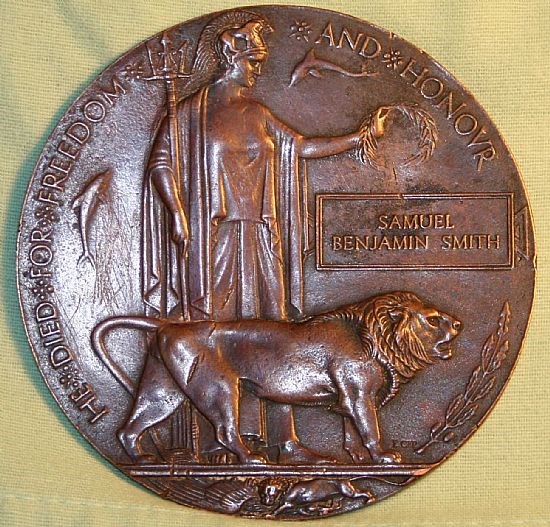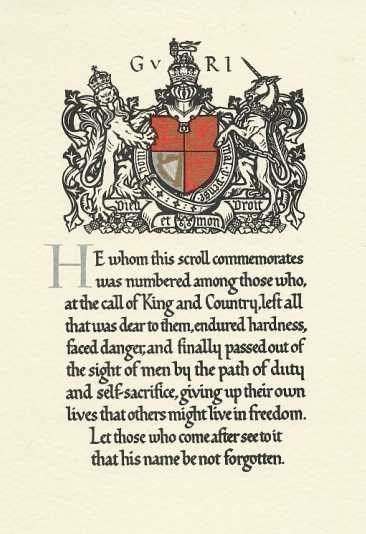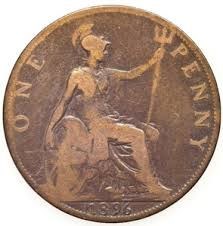The Widow's Penny
 "My Dad [David Oldham] found it in Keyworth about 50 years ago when he was building a house with Scattergood and Oldham. He can’t remember where though."
"My Dad [David Oldham] found it in Keyworth about 50 years ago when he was building a house with Scattergood and Oldham. He can’t remember where though."
Note from Erika Jalland (née Oldham) to Annie Rogers
The "it" referred to in Erika's note was a bronze disc about 4½ inches (11.4 cm) in diameter (see left).
Officially known as a "British & Commonwealth Next of Kin Memorial Plaque" (but often called a "Widow's Penny" or "Death Plaque"), these plaques were issued to the next-of-kin of all British and Empire service personnel who were killed as a result of the First World War.
The design incorporates the figure of Britannia. She is facing to her left and holding a laurel wreath in her left hand above the box containing the commemorated serviceman's name. In her right hand she is holding a trident.
There are two dolphins, each facing Britannia on her left and right sides, representing Britain's sea power. There is a lion standing in front of Britannia, underneath which is a smaller lion savaging a winged creature, representing the German Imperial eagle.
The words "HE DIED FOR FREEDOM AND HONOUR" are written around the margin of the circular plaque. Click here for more information about the design of the Memorial Plaques.
Each plaque was engraved with the name of the person it commemorated. In the case of the plaque found by David Oldham, this is "Samuel Benjamin Smith".
Samuel Benjamin Smith was born and brought up in Plumtree and Normanton. He was the son of Samuel Henry Smith and Eliza Smith (née Spittal) and was baptised at St Mary’s, Plumtree on 22nd March 1896. Both his parents were baptised and married in St Mary’s, Plumtree and both are buried in Plumtree churchyard, with no headstone.
Samuel Benjamin Smith's name appears on the Plumtree War Memorial, together with 18 other casualties of the First World War. He was a Private in the 1st / 8th Battalion, Sherwood Foresters (Notts and Derby) Regiment. He died on 14th October 1915, aged 19, and is buried at Cabaret-Rouge British Cemetery, Souchez, France (near Arras).
 The plaques were issued with a scroll containing the words:
The plaques were issued with a scroll containing the words:
"He whom this scroll commemorates
was numbered among those who,
at the call of King and Country, left all
that was dear to them endured hardness,
faced danger, and finally passed out of
the sight of men by the path of duty
and self sacrifice, giving up their own
lives that others might live in freedom.
Let those who come after see to it
that his name be not forgotten."
The plaques were produced from 1920 into the 1930s and, in total, around 1,355,000 were issued. About 600 plaques commemorated women (for whom it was necessary to fit in an "S" before "HE" in the inscription round the margin).
 Because of the similarity in appearance to the pre-decimal penny coin, the plaque became popularly known as the "Dead Man's Penny" or "Widow's Penny".
Because of the similarity in appearance to the pre-decimal penny coin, the plaque became popularly known as the "Dead Man's Penny" or "Widow's Penny".
Many families, especially those whose only income now came from what the next-of-kin could earn, felt the plaques were an insult and threw them away in disgust. This could explain why this one was found in a field in Keyworth.